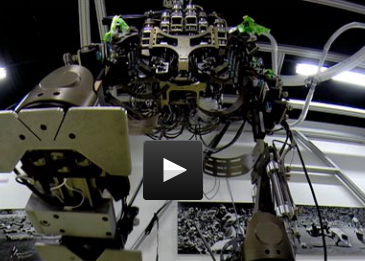Large-scale brain activity from a rhesus monkey was decoded and used to simultaneously control reaching movements of both arms of a virtual monkey avatar towards spherical objects in virtual reality.
In a study led by the Nicolelis Lab, monkeys have learned to control the movement of both arms on an avatar using just their brain activity. The findings, published on Nov. 6, 2013, in the journal Science Translational Medicine, advance efforts to develop bilateral movement in brain-controlled prosthetic devices for severely paralyzed patients. To enable the monkeys to control two virtual arms, researchers recorded nearly 500 neurons from multiple areas in both cerebral hemispheres of the animals’ brains, the largest number of neurons recorded and reported to date. Read the full article (PDF)
Videos
During the experiment, the monkey viewed two virtual arms of a rhesus monkey avatar from a first-person perspective and moved the arms towards circular targets to receive a small juice reward. |
Two Duke scientists observe the brain activity from nearly 500 neurons being recorded as the monkey enacted bimanual reaching movements with the arms of the virtual monkey avatar. |
Virtual monkey avatar shown from a 3rd person perspective as the movements of the two arms are decoded in real-time from a the brain of a rhesus monkey. In the experiment the virtual arms and 3D target objects appear on the screen from a first-person perspective to the monkey, who receives a juice reward for correctly performed trials. |
Brain activity from nearly 500 neurons was recorded as the monkey enacted bimanual reaching movements with the arms of the virtual monkey avatar. |
Screen as viewed by the monkey during experiments: a first-person perspective of the rhesus monkey avatar limbs. The movements of both virtual arms are decoded in real-time from brain activity while the monkey’s own arms were not permitted to freely move. The monkey must move the virtual arms to the circular targets to receive a small juice reward. |
Duke PhD student Peter Ifft observes brain activity from nearly 500 neurons being recorded as the monkey enacted bimanual reaching movements with the arms of the virtual monkey avatar. |







 Listen to the interview
Listen to the interview






